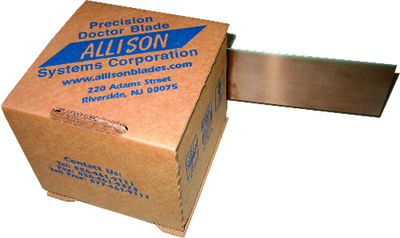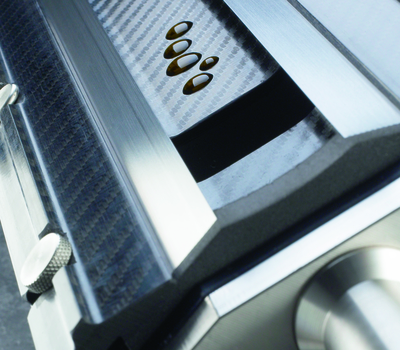Doctor blade chamber from Absolute Engineering
The precise metering of the ink that is transferred from the anilox roller to the plate is controlled by the doctor blade. Blades are made from either steel, hardened polymer or carbon fibre materials, and perform a vital function in the printing process. By Neel Madsen.
As part of the ink metering system, the doctor blade works in harmony with the anilox roller in the transfer of ink to the printing plate. The amount of ink is determined by the volume of the anilox roller, but it is the doctor blade that ensures a clean and precise transfer takes place.
The blade can either be mounted in a single blade holder at a reverse angle to the anilox, or in a chamber system, most commonly used on wide web central impression presses for higher running speeds.
Going for gold
As in all sectors of the market, the balance between costs and quality put increased demands on suppliers of doctor blades.
Bill Warner, vice president of Allison Systems Corporation, commented, ‘As the capabilities of the flexo process continue to improve, the demands on printers to produce higher quality is forcing them to demand higher quality products from their suppliers. At the same time the realities of today’s economy are forcing companies to lower their costs.
‘The struggle between higher quality products at lower cost is forcing printers to realise that the doctor blade with the lowest price isn’t always the best choice to controlling costs. If a doctor blade costs less to purchase but quickly fails to provide a clean wipe or damages the anilox roller, overall job costs go up due to printed waste, anilox repair and machine downtime.
‘Conversely a better quality doctor blade may initially cost more but will save money by reducing printed waste due to doctor blade related defects. Of course the best doctor blade can’t compensate for improper usage. This is where training in correct set up and operating procedures is so important to getting the most value from not only doctor blades but all components of the process.’
Allison Systems offers a wide range of metal, plastic and composite doctor blades. A good choice for dealing with abrasive inks and UV ink spitting issues is the ‘Laser Gold’ material, which comes with an added laser hardened tip for high wear applications. It is available in 6, 8, 10, and 12 mm thicknesses with rounded or standard bevels.
Its long life characteristics provide a stable working tip that remains small throughout the press run when compared to traditional carbon steel materials.
The standard bevel shape provides the smallest initial working tip of any of the bevels to cleanly wipe the UV ink from the anilox. ‘The standard bevel on our Laser Gold long life material is a winning combination that is hard to beat,’ concluded Mr Warner.
 Allison Systems’ Gold Blade
Allison Systems’ Gold Blade
The right combination
Print-Tech Solutions offers carbon steel, stainless steel or ‘long life’ materials with a range of profile options, such as bevel, lamella (stepped), round or square, as well as bespoke machined profiles for specialist applications. As it supplies other products for the flexo printing process, including ink pumps/filters, ink chambers and anilox rollers, it takes a holistic approach when advising customers on doctor blade selection.
Company owner, Steve Turner explained, ‘As we offer a wide range of related consumables, we are well placed to get involved with each customer’s individual requirements. The doctor blades are so closely related to other items within the flexo process, so we make sure that printers do not focus entirely on the doctor blades when print issues or quality improvements are under the spotlight.’
He continued, ‘Once our customers are comfortable that they are using quality steel, they will then be encouraged to identify where their main objective lies: blade longevity where the focus is entirely on getting the best meterage from the blade, or, consistent and repeatable quality, where blades tend to be changed as part of a regular press maintenance.’
Swedish steel
Founded in 1985, Swedev AB takes full advantage of its position to produce doctor blades under the Swed/Cut brand made from high quality Swedish steel. It exports 97% of its production to some 70 countries worldwide and has just announced plans for investment in additional production lines and expansion of its workshop facilities in Munkfors by 500 square metres.
Sören Ågren, director marketing and sales, spoke about the current market, ‘The growth in printing of flexible packaging and labels in particular is bringing on an increase in the use of UV inks, and this presents new challenges to both press and doctor blade manufacturers. Shorter job runs due to frequent graphic changes, more intricate graphic designs with bold bright colours and demands on consistently high print quality, as well as speed to market, are requirements bringing the higher end doctor blades into focus.’
The higher viscosity of UV inks brings along a number of changes in the printing process, such as higher forces in the moving ink, which requires more stable thicker doctor blades to avoid excessive blade movement, and higher inherent friction requiring blade materials that can decrease the total frictional forces.
The high friction and aggressiveness of white UV ink in particular can cause printing and cleaning problems, partly due to adhesion of ink and sliver formation at the tip. Both the alloyed steel grade and lubrication coating of tip cross-section (Fig 1) are beneficial for handling and lowering total frictional forces.
Demands of high print quality require a doctor blade tip that is sensitive enough to do a clean wipe of the anilox or printing cylinder at a high enough contact angle to avoid the formation of slivers. Thus the preferred product is often a compromise of thicker blade (0.20-0.30 mm) with a thinner lamella tip (eg 1.5/0.10 mm). Packaging of the blades in pre-cut lengths saves time in job changeovers, serving increased speed to market for the printers.
‘Future developments are aimed at matching the correct balance of wear resistance and lowering of friction with each customer’s set of printing machines and variety of printing jobs,’ concluded Mr Ågren.
Italian expertise
Eurograv Limited has been the UK and ROI distributor of doctor blades from Italian manufacturer CBG Acciai since the early 90s. Director Mike Attard said that the company sees that today, more than at any other time, the whole ink metering process is one major area where big improvements to colour consistency and print quality can be achieved with the correct selection of doctor blade.
CBG recently developed a new Wing Lamella profile, which has been awarded a patent. This blade has been seen to give flexo operators a more consistent colour throughout the blade life and also improve the sealing of the chamber and the seals when compared with traditional lamella or round edge blade. Furthermore, the new profile has a much finer wiping area and is particularly well suited for use with high screen anilox rollers as a lower pressure can be used.
The Wing Lamella blades can also be augmented with several different coatings for those running special inks or printing extended colour gamut, where blade changes must be kept to a minimum.
Several of CBG’s UK customers are reporting that by using the blade with ‘Super’ coating on standard colours with high line anilox rollers, they are achieving up to 1.5 million metres without blade change.
All CBG’s blades are manufactured using high quality Swedish steel and Mr Attard said that its strict qualitycontrol requirements and the development of the Wing and various coatings has resulted in a dramatic increase in sales. He concluded, ‘The fact that we also offer our clients a one-to-one ‘on press’ consultation process is allowing them to implement the improvements in the ink metering process that the correct selection of doctor blade can achieve.’
Nano blades
Swedish supplier PrimeBlade AB manufactures doctor blades for flexo, gravure, offset and coating applications. As well as offering traditional polymer, carbon steel and stainless steel blades, it has brought to market the 900 Nano series. This takes advantage of nano technology to produce three types of specially treated blades, which offer very long life times.
Kenth Sandström, general market and sales manager, said, ‘Many customers still regard the doctor blade as a consumable only, and not as a very important tool for quality. The driving factor is mainly price. Often printers are investing in premium 10 colour presses, but using low quality end seals (leaking issues and life time) and basic doctor blades, instead of looking at productivity. In flexo, it is very important to find a combination of end seals and blades that work well together. If the lifetime of the end seal is too short, then the lifetime of the blade is shorter as they are usually changed at the same time.’
 Fig 1 Friction-resistant alloyed steel with lubricating coating for doctoring UV ink (Swedev)
Fig 1 Friction-resistant alloyed steel with lubricating coating for doctoring UV ink (Swedev)
With warranty
Absolute Engineering, which was recently acquired by Pamarco Global Graphics, manufactures carbon fibre doctor blade chambers. Its ‘2G’ woven carbon fibre dual chamber system comes with a 15 year warranty against corrosion.
Packaging printer Hovat Ltd purchased its first carbon fibre chamber in 2008, and now five years later, it has installed another 12 systems from Absolute, replacing the aluminium systems that were originally supplied with its Uteco press.
The 15 year warranty has proven itself to director, Kevin Beamon, ‘Our original carbon fibre chambers still look and perform like new, and so when it came to replacing the traditional aluminium ones, it was the obvious decision. In terms of performance, we find that the carbon fibre absorbs shock and vibration in the print deck, and this allows us to run our flexo presses faster. This combined with the permanent ink repelling surface of the system, more than pays for the carbon fibre premium.
Antony Whiteside, managing director of Absolute, commented, ‘We are also a growing company, and whilst we are constantly looking for new opportunities, we actively support our existing customers by working with them to optimise press performance.
Long term relationships with companies, such as Hovat, provide the majority of our business, and we do everything possible to nurture this.
It is good to see customers investing in equipment giving performance improvements that keep them ahead of their competitors.’






